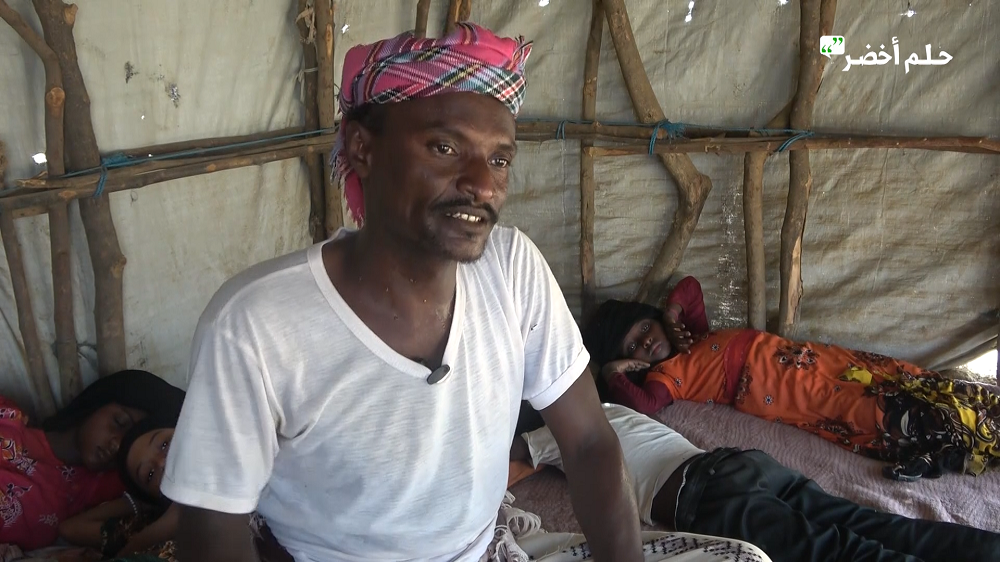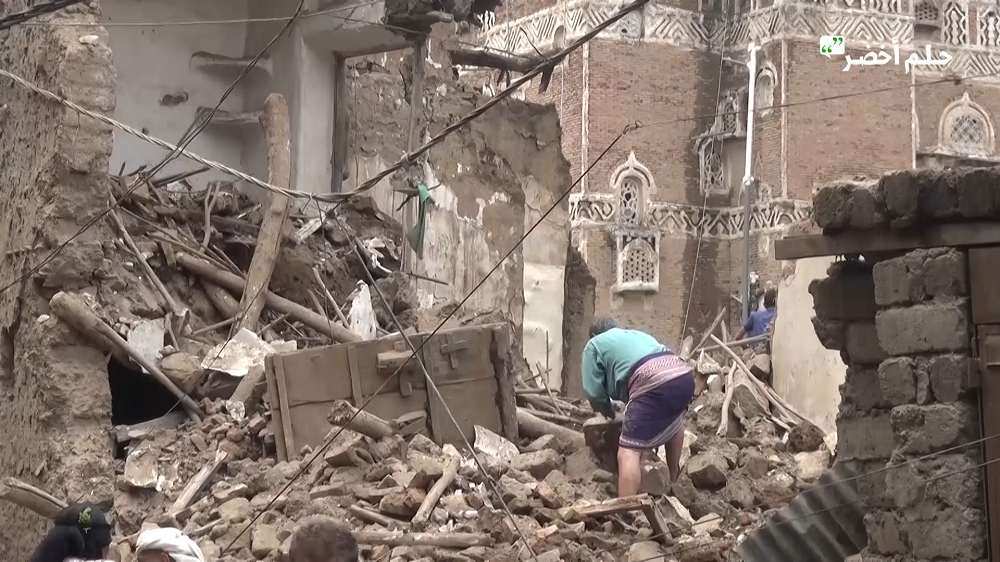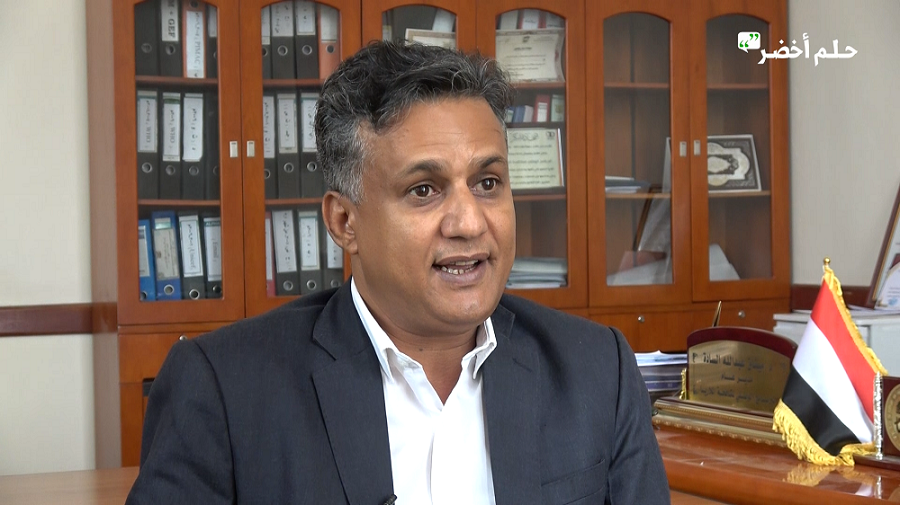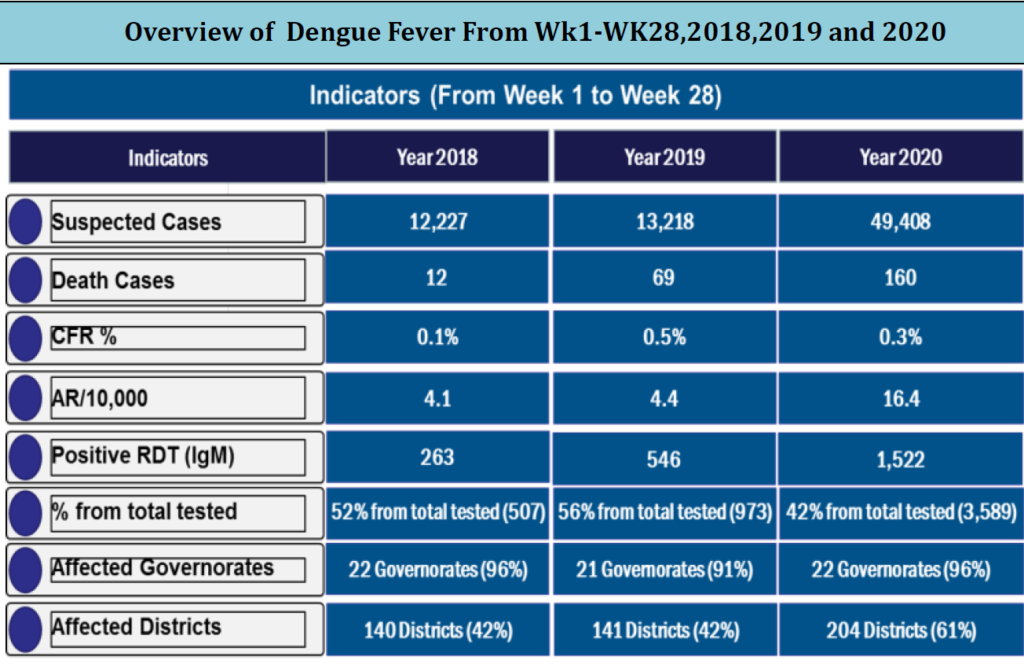Investigation by: Holm Akhdar
Here in the western Tihama, in the center of “Abs” district in Hajjah province, northwest of the capital Sana’a. As the monsoon blows, Issa Yahya Shaddad, along with his wife and children, is sheltering in a small hut inside the camp of Al-Khadesh.
Issa, from his rural home town of Haradh, bordering Saudi Arabia, was displaced after the war had turned it into a ruin. His four children were infected with the dengue epidemic.
“I moved from the village of Al-Mazarq, and arrived at this camp (Al-Khadesh). All my children had dengue fever. I took them to the relief organization to fetch for help but all they did was give me some pills and asked me to go treat my children at home,” Issa, told Holm Akhdar. “I can’t afford medicine. All I can do now is stay close to my children and wait for God’s judgment and destiny.”


Yemen: Conflict, Floods and Diseases
Since the war broke out in 2015, Yemen has experienced severe climate disasters that were not familiar before. Seven severe tropical cyclones hit coastal areas in the southeastern part of the country. The damage has worsened dramatically, and both the humanitarian and economic costs have increased.
Early in 2020, the situation was even more difficult, as the country was hit by extreme weather events, during a bitter conflict and a humanitarian crisis described by UN agencies as the worst in the world.
In April, 2020, heavy rains hit the country for the first time. More rain followed in June in the southern and eastern provinces. The rains continued throughout July and intensified until August.
In early May 2020, UN warned of the impact of flash floods on water sources in Yemen, and caused damage to potable water supplies.”There is an increased risk of outbreaks of diseases such as malaria, dengue fever and cholera from the rain,” OCHA said in a press release.


Tihama the Most Affected
During this year the tropical depressions positioning over the eastern and southern regions of Yemen, it rained with thunderstorms, the country’s cities were flooded, and 19 Yemeni provinces were affected.
Hajjah is one of the most area vulnerable to danger and affected by floods this year. then Al-Hodeidah Governorate, located on the Red Sea coast. According to OCHA, 29,000 families have been affected by floods during the past months from these two governorates.
Tihama geographically (Al-Hodeidah/Hajjah) was one of the areas most affected by the emergence of epidemics and fevers”, as Dr. Methaq Al-Sadah said, Director of the National Malaria Control Programme NMCP, in Sana’a.
“At the national level, Tihama is one of the regions most affected by these fevers due to the presence of climatic factors. The number of malaria cases has reached 200,000 as confirmed in 2019, and about 74,000 suspected cases of dengue fever and chikungunya.” Dr. Methaq told Holm Akhdar. “There are many factors that have led to a high number of cases of fever, namely climate change and heavy rains, and the displacement of people from infected areas to disease-free areas.”

Dengue Fever 2020: are four times the cases
Perhaps the last thing Yemenis had expected during a bitter war and a major humanitarian crisis was a sudden climate disaster. And fevers outbreaks.
According to OCHA, 96,000 families were affected by the floods in Yemen, many of which were displaced.
Since the onset of the outbreak in Yemen, dengue suspected cases to date continue to increase during 2020 comparing with 2019, the suspected cases up to week 28 are four times the cases in comparison 2019, and six times the reported numbers in 2018, according to the Yemen Health Cluster. (Table1)

Yemeni Children below five years old are 11% of the total caseload and 30% of the total death cases. Dengue outbreaks have affected 174 of 333 total districts (54%) in 22 of 23 governorates of the country, according to the IFRC.
According to the latest epidemiological bulletin Issue 35 (covering week 35 up August, 25-31, 2020), The number of people infected with dengue fever increased to 50,747 cases by the end of August 2020 compared then to 16,645 cases in 2019. (Table 2)

IFRC said, “the number of affected governorates is likely to increase due to the collapse of the health system in Yemen, the poor water and hygiene condition in the most affected areas, additionally due to the ongoing complex and protracted conflict, with limited access to humanitarian support to the most vulnerable and affected populations.”

Aden: Fever Cases was Unimaginable
On the other side, the scene was even more devastating, in the southern province of Aden. The number of fever cases was unimaginable. Its symptoms overlapped with the Outbreak of Covid-19 and disrupted the city’s dilapidated health system.
Dr. Isharq Al-Sebaei, the Spokesperson of the National High Emergency Committee and the Covid-19 told Holm Akhdar the number of fever cases was very high in Aden.
“More than 35,000 cases of fever, at the level of the southern provinces, were directly related, as the fevers coincided with the emergence of Covid19. There was a correlation in some of the common symptoms between these fevers and The Covid19.” Dr. Isharq Al-Sebaei said.
“For the southern provinces, more than 15,000 cases of dengue fever have been detected. Other fevers do not make much a difference. The death toll from dengue fever has reached nearly 100.”. Explained Dr. Al-Sebaei
The floods created a new crisis within the Yemeni crisis the country, leaving the population vulnerable to exacerbated by environmental shocks and epidemics as the 50% health system which had already been devastated by the war, collapsed.


Following the heavy rains in Aden, the family of Qassim Faraj Musa contracted chikungunya, a viral disease transmitted by mosquitoes in water and swamps.
“My whole family had been infected by chikungunya. My wife was the last of those infected, and the hospitals here were afraid to receive patients from fear of Covid19 cases. My wife has not recovered yet. We treat her by giving her lemon juice with tamarind, that is the treatment we have.” Qasim told Holm Akhdar.
In mid-May, the local media reported a statistic from the Aden Civil Status Department that it had issued some 527 permits to bury the bodies of those dead from fever swells in Aden.

National climate emergency
Yemeni meteorological indicators showed an increase in rainfall for 2020, and the data showed fluctuating timings and different quantities from one region to another.
“On June 21, 2020, the amount of rain was about 125 milliliters. It was a great disaster for Aden. The estimated losses amounted to 1.9 billion dollars in the provinces of Aden, Hadhramaut and Lahj, “Engineer Alawi Muhmmed Abdullah, Meteorologist at the Aviation and Meteorological Authority in Aden. told Holm Akhdar.
“The most prominent factors that exacerbated the flood disaster are indiscriminate construction. In recent years, the indiscriminate construction of Aden has been increasing dramatically. The disaster was exacerbated”. Alawi said.
Today, weather events are becoming more frequent and intense, making Yemen in the face of a climate emergency that requires an immediate response and the adoption of a risk management approach.

“Yemen is a dilapidated country. Infrastructure is dilapidated, and sanitation is damaged. Clean drinking water isn’t delivered to the houses. The roads are full of excavations. If there is no sustainable plan to rebuild the sewage system, access water supplies to every house, and repair roads that have also been mosquito hotspots, we will not be able to get rid of the fever.” Dr. Isharq said.
Yemen urgently needs to declare a state of climate emergency. The disasters in this afflicted country will be “humanitarian”, not “natural” as the authorities think.
#Yemen urgently needs to:
– adopt different environmental, comprehensive and equitable policies to manage the risks of increasing natural disasters.
– draw up a climate-change contingency plan.
– establish a national center for climate emergencies.
– declare a climate emergency. pic.twitter.com/NXc4RDRZCc— حلم أخضر Holm Akhdar (@holmakhdar) August 28, 2020
* This article was produced by: Holm Akhdar team, in Sana’a, Hajjah and Aden.
** Watch the video: Yemen: Climate change & high incidence of fevers
